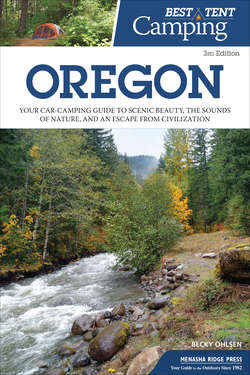Читать книгу Best Tent Camping: Oregon - Becky Ohlsen - Страница 25
На сайте Литреса книга снята с продажи.
Оглавление6
Cape Perpetua Scenic Area Campground
Beauty Privacy Spaciousness Quiet Security Cleanliness
All along this portion of the sculpted coast is an endless array of rugged inlets, crescent-shaped coves, and towering capes.
KEY INFORMATION
CONTACT: American Land & Leisure for Siuslaw National Forest, Central Coast Ranger District: 541-547-3289, www.fs.usda.gov/recarea/siuslaw/recreation/camping-cabins/recarea/?recid=42273
OPEN: Mid-March–early October
SITES: 37, 1 group
WHEELCHAIR ACCESS: Restrooms, group site, sites 34–38
EACH SITE HAS: Picnic table, fire ring with grill
ASSIGNMENT: First come, first served, or by reservation at 877-444-6777 or recreation.gov
REGISTRATION: Self-registration on-site
AMENITIES: Flush toilets, piped water, dump station, visitor center
PARKING: At campsites (back-in parking recommended); $7/additional vehicle
FEE: $26; $10 reservation fee
ELEVATION: Sea level
RESTRICTIONS:
PETS: On leash only
QUIET HOURS: None specified
FIRES: In fire rings only
ALCOHOL: Permitted
OTHER: RVs up to 22'; 14-day stay limit
Cape Perpetua, the last of the trio of capes with campgrounds we recommend, got its name from Captain James Cook in 1778. Cook passed by as he fearlessly continued north on his fruitless search for the Pacific link to the Northwest Passage. Both Cape Perpetua and the nearby town of Yachats (pronounced “yah-hots”) have long been favored vacation destinations for Oregonians who appreciate the small town’s relative seclusion amid some of the coast’s most awe-inspiring scenery. For some unknown reason, Yachats is often overlooked by tourists heading for the bustling centers of Newport and Florence, nearly equidistant to the north and south respectively.
Long before tourists had a road to take them anywhere in this vicinity, however, the fog-shrouded seashore and mountain slopes were the domain of coastal American Indian tribes, including Tillamook and Alsea, who fished, clammed, and hunted in blissful obscurity. Their contentment was short-lived once the Spanish, English, and Germans discovered the rich resources in the area. Along the coast and up nearby verdant river valleys, timber mills, fish canneries, and dairy farms thrived from the late 18th century through the 20th. While there is still significant activity in these traditional industries, tourism has begun to replace them in the last several decades. Waning resources have forced residents of towns and villages all along the Oregon coast to consider alternative methods of making a living. The transition has not been easy for many of them.
Drive up to Cape Perpetua viewpoint for a dizzying panorama.
While tourism has only recently seen dramatic growth, the makings for a tourism boom were first put in place in the 1930s with the extension of US 101 and the construction of the first Cape Perpetua Visitor Center by the Civilian Conservation Corps. Today’s center is a renovated version of the original, and there is still evidence of the Depression-era workers’ housing on the trail between the center and the beach.
The center is a good starting point before taking in the sights of this unique area. As the focal point of the surrounding piece of land known as the Cape Perpetua Scenic Area, the center offers educational exhibits and films as well as a small bookshop. Trails from the center lead off into stands of old-growth spruce in one direction and under the highway to the beach in another. All in all, there are 22 miles of hiking trails within the scenic area. Flanked by state parks on its north and south sides, a wilderness area on the east, the highly photogenic Heceta Head Lighthouse not far south, and the famed Stellar Sea Lion Caves just beyond that, Cape Perpetua Scenic Area has no lack of interesting day trips for visitors based at the campground.
Ah yes, the campground. Cape Perpetua Campground is actually two camping areas within the jurisdiction of the Siuslaw National Forest (as is the rest of the scenic area) but managed by a private contractor, American Lands & Leisure. Both are quite close to the visitor center, and the only difference between them is that one is an individual-site complex and the other accommodates groups of up to 50 people. Although privacy at the individual-site campground is painfully lacking because the sites are stretched out along the access road with little vegetation between them, at least they are situated between a creek and a cape, to give the feeling of being tucked away. Most other campgrounds in the immediate area are sprawling compounds that no one would describe as peaceful.
The campground operates mid-March–early October, but it’s worth mentioning that the wild and windswept Cape Perpetua is an enormously popular whale watching spot in the wintertime. Although the campgrounds are not open, the visitor center has interpretive programs for the whale watching crowd.
If you want to witness prime examples of the geologic magnificence found at Cape Perpetua Scenic Area close up, stop at the scenic overlooks for Devil’s Churn and Cook’s Chasm right off the highway. The relentless movement of sea against basalt rock has formed overhanging cliffs and caves, which are pounded mercilessly at high tides by clashing currents that explode as high as 60 feet into the air. The effect is exhilarating.
All along this portion of the sculpted coast is an endless array of rugged inlets, crescent-shaped coves, and towering capes. Just south of Devil’s Churn is the road up to the Cape Perpetua Viewpoint. At 800 feet above the sea, you can have a bird’s-eye view of this breathtaking panorama in all directions.
GETTING THERE
From the intersection of OR 126 and US 101 in Florence, take US 101 N and drive 23.1 miles. Turn right (east) into the park.
From the intersection of US 20 and US 101 in Newport, take US 101 S and drive 26.7 miles. Turn left (east) into the park.
GPS COORDINATES: N44º 16.942' W124º 06.411'
